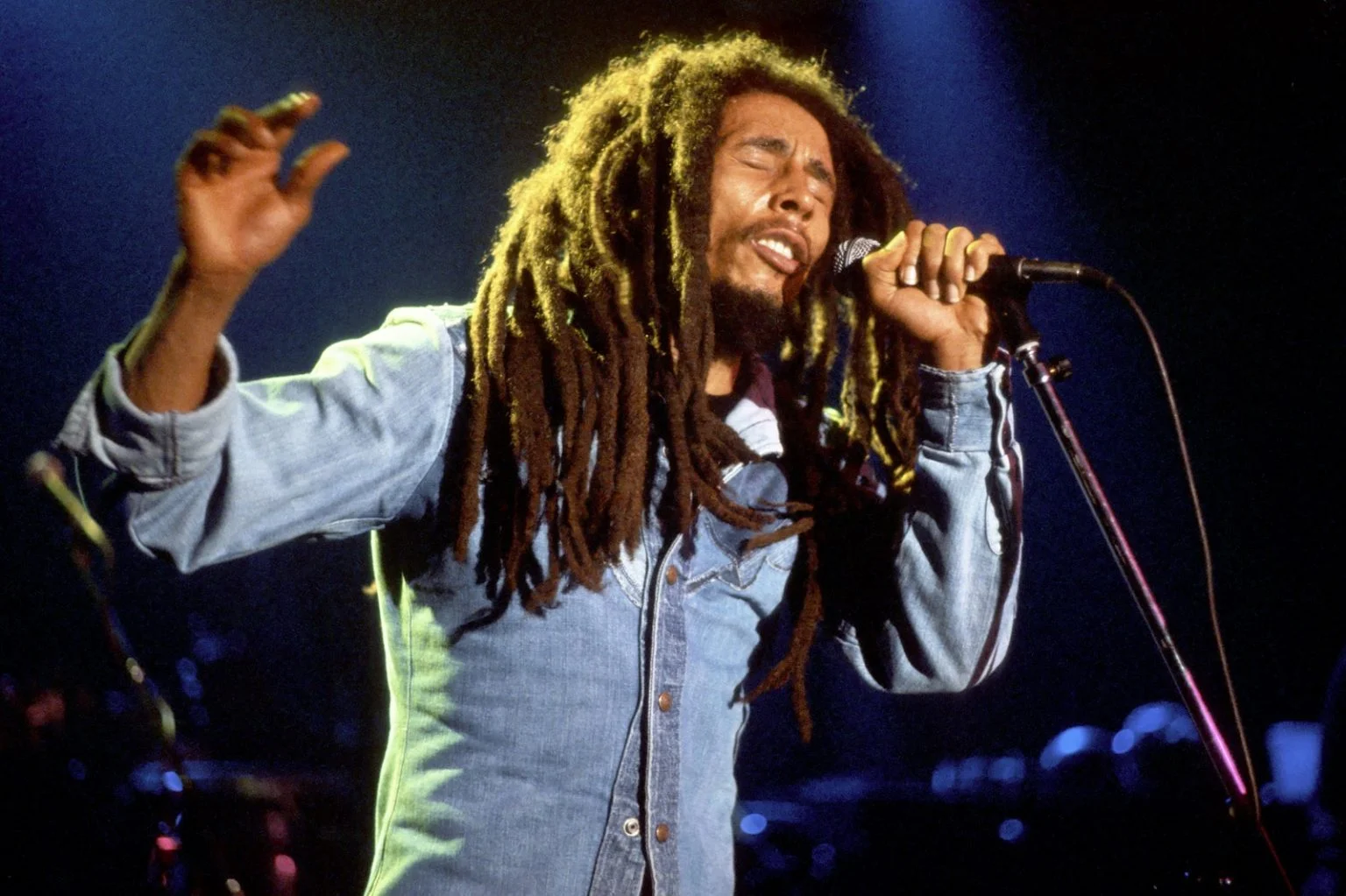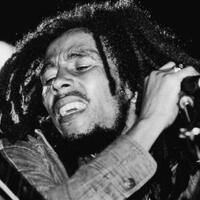Quick Facts
| Net Worth: | $32 Million |
| Date of Birth: | Feb 6, 1945 – May 11, 1981 (36 years old) |
| Place of Birth: | Nine Mile |
| Gender: | Male |
| Height: | 5 ft 7 in (1.72 m) |
| Profession: | Singer, Musician, Guitarist, Songwriter |
| Nationality: | Jamaica |
Bob Marley was a Jamaican reggae musician, and before he arrived on the scene, reggae music was a niche genre that barely spread outside of Jamaica. The singer formed Bob Marley and the Wailers, and with them, Marley almost made reggae a mainstream genre. Also he was known for his outspoken support for marijuana legalization, which was a hot topic at the time, and he was the target of an attempted assassination.
Following his death from cancer, the entire world felt stung, and monuments in his honor have been erected all over the world. “One Love,” “Jammin,” and “No Woman, No Cry” are among Marley’s most popular songs.
How Much Was the Net Worth of Bob Marley ?
Bob Marley was a reggae singer, songwriter, and musician from Jamaica. Bob’s estate was worth $11.5 million at the time of his death in 1981. In today’s inflation-adjusted dollars, that equates to $32 million.
Bob Marley is regarded as a reggae pioneer and an icon of the Rastafari movement. Marley’s records have sold over 75 million copies worldwide, making him one of the most successful musicians of all time. In 1981, he died of acral lentiginous melanoma.
ALSO READ THE NET WORTH OF: Johnny Nash
Wealth and Estate Conflict
Marley’s music and image rights generated hundreds of millions of dollars in income for his heirs in the decades following his death. According to reports, authorized and unauthorized licensing fees generate more than $500 million in revenue per year. Only authorized (legal) transactions benefit the estate. Today, royalties from the estate bring in between $25 and $30 million per year for the family. If Bob Marley were still alive today, he would be worth well over $200 million.
Unfortunately, Bob died without a will, allegedly because his Rastafarian faith forbade him from acknowledging his own mortality by creating something resembling a will.
When a person dies without a will, also known as “intestate,” 10% of their estate is immediately distributed to their widow, according to Jamaican law. The widow can eventually accumulate an additional 45% share of the estate over time, for a total of 55%. The remainder is divided equally among any living children. And when Rita dies, his living children inherit complete control.
Jamaican law also requires that an advertisement seeking potential heirs be posted following the person’s death. In the case of Marley, this ad drew hundreds of applications from people claiming to be his children.
His widow, Rita Marley, forged Bob’s signature on a will that allegedly pre-dated his death, with the encouragement of some shady advisors. This will leave her with the majority of his estate. When one of Marley’s longtime business managers discovered what had happened, he ignited a 10-year legal battle that cost $6 million in legal fees, roughly half the estate’s value.
In the end, the Jamaican court ruled that Chris Blackwell, the owner of Bob Marley’s record label Island Music, should retain control of Marley’s estate. Blackwell managed the estate through Island Logic Ltd until 2001, when Rita Marley and his 11 recognized legitimate children took full control.
Early Years and Childhood
Robert Nesta Marley was born on February 6, 1945, in Nine Mile, Saint Ann Parish, Jamaica, to 59-year-old Norval Sinclair Marley and 18-year-old Cedella Malcolm. His father was a white Jamaican from Sussex, England, who worked as a plantation overseer and served in the Royal Marines. Bob saw his father rarely, and after Norval died in 1955, Cedella and Bob moved to Trenchtown.
Cedella later married Edward Booker, an American civil servant, and gave Bob two half-brothers, Richard and Anthony. Marley also had a half-sister, Claudette, who was the result of his mother’s relationship with Thadeus Livingston, the father of Bob’s friend and future bandmate Bunny Wailer.
Bob and Bunny were childhood friends who used to play music together at Stepney Primary and Junior High School in Nine Mile. Bob and Bunny joined a vocal group with Peter Tosh, Beverley Kelso, and Junior Braithwaite while living in Trenchtown. Joe Higgs, a musician who lived nearby, mentored the group, giving them vocal lessons and starting to teach Marley how to play guitar.
YOU MAY ALSO LIKE TO READ: Lil Gnar
Career in Music
Marley’s musical career began in 1963, when he formed The Wailers with Bunny Wailer, Peter Tosh, Junior Braithwaite, Beverley Kelso, and Cherry Smith, forging a distinct songwriting and vocal style that would later resonate with audiences worldwide. The Wailers collaborated with producer Lee Scratch Perry on some of the earliest reggae records, and their single “Simmer Down” reached number one in Jamaica in February 1964.

Marley pursued a solo career after the original line-up disbanded in 1974, culminating in the release of the album “Exodus” in 1977, which established his worldwide reputation and put Marley on the map as one of the world’s best-selling artists, with sales of more than 75 million albums and singles.
Marley released 13 studio albums (1 posthumously) and 6 live albums, with notable singles including “Redemption Song,” “I Shot the Sheriff,” “No Woman, No Cry,” “One Love,” and “Get Up, Stand Up.” Though Marley was best known for reggae, his music also included ska and rocksteady elements, and his greatest hits album, “Legend,” is the best-selling reggae album of all time.
Private Life
Bob married Alpharita Constantia “Rita” Anderson on February 10, 1966 in Kingston, Jamaica. He fathered four children with Rita and adopted two of her previous relationships’ children. He had 5 children with other women as well. Ziggy, Stephen, and Damian, his sons, went on to become Grammy-winning reggae musicians. Marley spent most of his life in Jamaica, but he moved to London following an assassination attempt in 1976 that killed Bob, Rita, manager Don Taylor, and band employee Louis Griffiths.
Rastafari Marley’s music reflected his spirituality. Marley was a member of the Rastafari Twelve Tribes Mansion and the Tribe of Joseph because he was born in February, according to his biographers (each of the twelve sects being composed of members born in a different month).
Marley’s Rastafarian faith influenced his Pan-Africanism. Bob advocated for marijuana legalization. After converting to Rastafari in 1966, he was arrested and fined for marijuana possession in London in 1968.
Disease and Death
Marley was diagnosed with a malignant melanoma under his toe in July 1977. Marley’s doctor recommended that he have his toe amputated, but Bob refused due to his religious beliefs and the possibility that an amputation would interfere with his ability to perform. Marley chose to have the nail and nail bed removed, and the area was covered with a thigh skin graft. He kept touring, and his final show was on September 23, 1980, in Pittsburgh, Pennsylvania.
He had collapsed while jogging in Central Park two days before and learned during a hospital visit that his cancer had spread to his brain. Bob decided to return to Jamaica after attempting an alternative cancer treatment at Josef Issels’ Bavarian clinic.
His condition worsened during the flight, and when his plane landed in Miami, he was taken to Cedars of Lebanon Hospital (now University of Miami Hospital). Marley died on May 11, 1981, at the age of 36. “Money can’t buy life,” he said to his son Ziggy before dying. Marley was given a state funeral in Jamaica, which later awarded him the Order of Merit.
Legacy
Marley was inducted into the Rock and Roll Hall of Fame in 1994, and “Time” named “Exodus” Album of the Century in 1999. In 2001 and 2004, Marley received a Grammy Lifetime Achievement Award and a Hollywood Walk of Fame star.
He was inducted into the UK Music Hall of Fame and ranked #11 on “Rolling Stone100 “‘s Greatest Artists list. Bob Marley’s former home at 56 Hope Road in Kingston was turned into the Bob Marley Museum in 1987.






